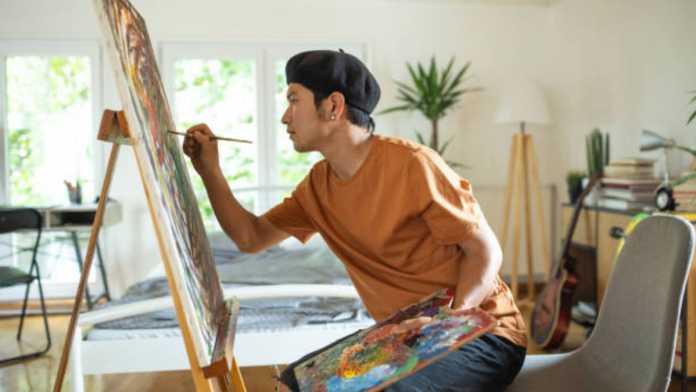Egon Schiele was a rebellious artist who broke the stereotypes of traditional art. He dropped out of art school but never stopped making art. Egon Schiele’s art was more diverse than you can ever imagine. He did over 3000 paintings on paper and nearly 300 on canvas using oil paints.
Having such a fantastic record makes Egon Schiele a prolific painter, one of a kind. His artistic knowledge was outstanding, and one thing which set apart his works from others was his unique style.
He never followed the trends but created so many of them. The artist’s main focus was to showcase the true spirit of art. In the segment below, we have listed some of the most iconic self-portraits by Egon Schiele, which illustrate a deep sense of his artistic manifestations.
Egon Schiele With Striped White Shirt
In 1910, famous Egon Schiele painted this illustrative self-Portrait in which he wears a striped white shirt. In this painting, Egon is a young man who is seen inquisitively with big, intriguing eyes.
The spiritual side of the painting is attenuated with big eyes, a high forehead, unruly hair, and a brushed appearance. His neck appears petite and slender. Egon sketched this one with sparse lines and painted it in beautiful watercolor shades. This combination adds more balance to the artwork.
For skin, he chose a contrast of gray for the brow with the pale red tints of the cheeks and ear. He added traces of vivid blue on the cheek and enhanced his brown hair with variants of purple. Concludingly, this artwork is, in every aspect, a unique and personal masterpiece. It is a carefully considered composition, and the artwork’s intuitiveness plays equal parts.
Peacock Waistcoat Standing
Egon Schiele’s painting, Peacock Waistcoat Standing, is considered one of his most unusual paintings. The paper is filled with bold colors. He is not naked but in a state of misery. However, the gaze he transmits is arrogant and proud. Egon slips into the role of a nobleman, well-dressed in a waistcoat with an on-point shirt collar.
It’s the first time in Schiele’s work that the gesture in V shape is visible. He mimics the gesture of the universal ruler who brings salvation to the world, highlighting that art can do the same and powers beyond it.
The point of difference between some of Egon Schiele’s paintings and this one is that Schiele is dressed very elegantly. Even though it was a time when he was extremely poor, this portrait is not depicting reality; rather, it illustrates Schiele’s fantasy.
Self Portrait With Chinese Lantern Plant
This is one of the most celebrated self-portrait paintings done in 1912 by Egon Schiele. The painting depicts a confident yet vulnerable side of the master himself. In the artwork, both his hair and torso are by the edges of the canvas.
The face is painted with richly colored brushstrokes. The lines in the composition are quite expressive and striking. There is so much detailing, like the jawbone as a continuation of the shoulder line.
The left shoulder lies slightly in the slant with a two-tone white background. There are twigs with leaves. The Chinese lanterns on the left side of the portrait appear very delicate. These elements echo the artist’s depiction of himself as slightly fragile.
Initially, the painting was exhibited in Munich alongside a portrait of Wally Neuzil. But unfortunately, the Nazis stole Wally’s portrait from a Jewish Austrian’s home.
Hermits
Hermits by Egon Schiele is a double portrait in which he paints himself and his mentor, Gustav Klimt. They both are standing close together.
The figures are wearing long black caftans, a loose dressing style of that time. It was an item of clothing that both the artists wore. Klimt and Schiele were known for wearing them in real life.
Schiele is positioned behind Klimt’s partially concealed and blinded windows. With bold and dark colors, Schiele paints himself as the old master rather than Klimt. The title of the painting puts light on Schiele’s feelings. As he mostly lived on the isolated fringes of society.
Self-Portrait, 1911
In the year 1911, Egon Schiele came up with his potent subject matter for both paintings and drawings. This self-portrait used a series of watercolors and art techniques different from the other.
It was from a series of paintings produced between 1910 and 1918. However, this prime example sheds light on psychologically complex images. It represents a tortured figure of the artist, who is bony, angular, and bristles with inner tension. The agitated pencil line and painted white surrounding all these gestures are made visible.
He wildly stares, his large, dark eyes glaring menacingly with an open mouth and his shock of hair standing on end. He casts a striking pose that is just like the crucified Christ. In which his arm thrusts out awkwardly and bends sharply at the elbow.
The Bottom Line
Egon Schiele was an artist with a mindset above the ordinary and an artistic style that outshined everyone. The best of Egon Schiele’s paintings are available online as reproductions in various art galleries that promise fast deliveries. They are authentic oil on canvas, made by highly-skilled professional painters from across the globe.







